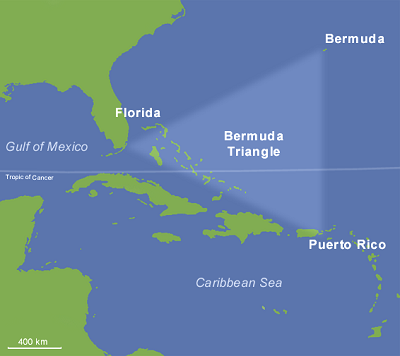Siberian Craters Used to Explain Bermuda Triangle
The discovery over summer of three craters in Russia has led to a spate of speculation about aliens, meteorites and missiles. Now the Science in Siberia journal has linked the craters to the Bermuda Triangle where ships and planes are said to have disappeared under mysterious circumstances.
Scientists from the Trofimuk Institute of Petroleum-Gas Geology and Geophysics in Novosibirsk have postulated that the Siberian craters formed as the result of an explosion linked to the release of gas hydrates triggered by unusually warm climatic conditions and heat from geological fault lines. The particular crater that the scientists studied in Yamal is up to 70m deep and 50-100m wide.
 The Times of Siberia reports Igor Yeltsov, the Trofimuk Institute's deputy head, as drawing a parallel with the explosions causing the craters and the gas hydrate theory that has been postulated to explain that the Bermuda Triangle.
The Times of Siberia reports Igor Yeltsov, the Trofimuk Institute's deputy head, as drawing a parallel with the explosions causing the craters and the gas hydrate theory that has been postulated to explain that the Bermuda Triangle.
“They start to actively decompose with methane ice turning into gas. It happens in an avalanche-like way, like a nuclear reaction, producing huge amounts of gas. That makes the ocean heat up, and ships sink in waters which are infused with huge amounts of gas. This leads to the air becoming supersaturated with methane, creating an extremely turbulent atmosphere, leading to aircraft crashes,” he says.
There are cases often cited as proof of the existence of the Bermuda Triangle. In 1881, the Ellen Austin reportedly came across a derelict ship in the Bermuda Triangle and placed a crew onboard. They attempted to sail the vessel to New York, but reports say that it disappeared and then reappeared without a trace of the crew. In 1918, the USS Cyclops set sail from Barbados but went missing in the area with a crew of 309 people lost.
Laboratory experiments carried out in Australia over a decade ago have proven that bubbles can sink a scale model ship by decreasing the density of the water. It has been hypothesized that periodic methane eruptions may produce regions of frothy water that are no longer capable of providing adequate buoyancy for ships. If this were the case, such an area forming around a ship could cause it to sink rapidly and without warning.
Publications by the US Geological Survey describe large stores of undersea hydrates worldwide, including the Blake Ridge area, off the coast of the southeastern U.S. However, according to the US Geological Survey, no large releases of gas hydrates are believed to have occurred in the Bermuda Triangle for the past 15,000 years. Additionally, the insurance market Lloyd's of London has determined that no more ships have sunk in that region than in other parts of the ocean, says the U.S. Geological Survey.
Lovers of mystery still cling to the idea of the Bermuda Triangle and to explanations that blame it on leftover technology from the mythical lost continent of Atlantis. Locals call the Russian craters the ‘end of the world’, and it seems likely that the theory of alien invaders, rather than gas hydrates, is also likely to live on.
